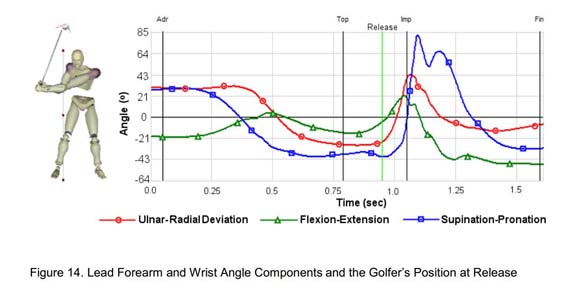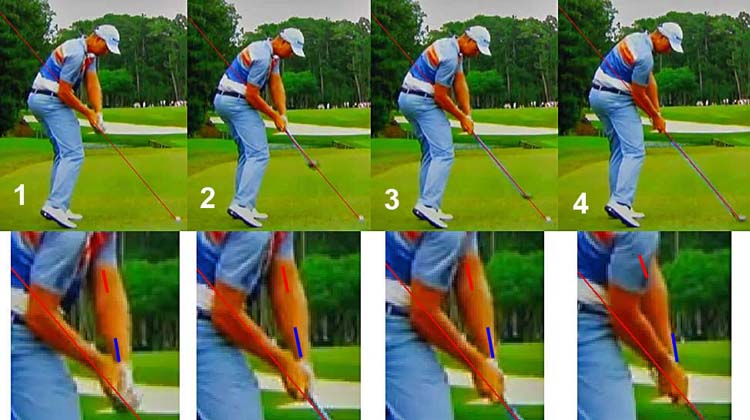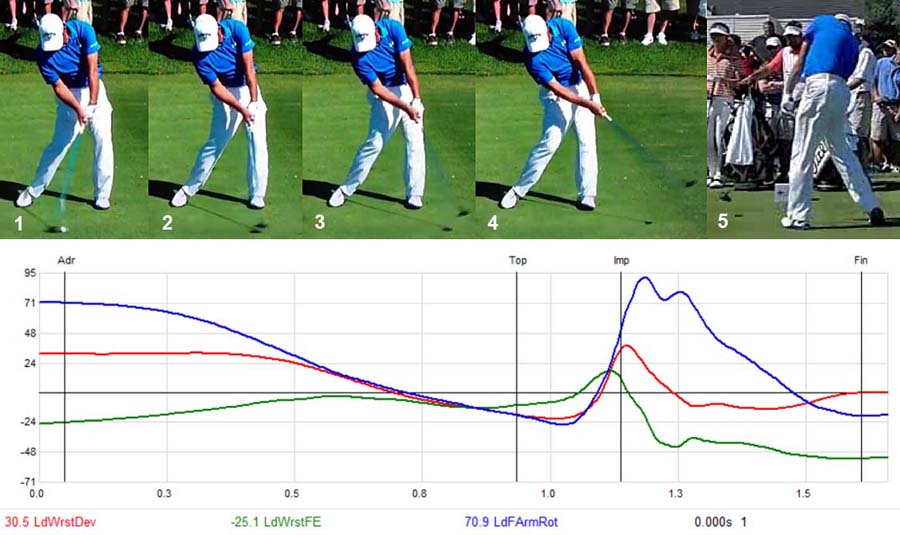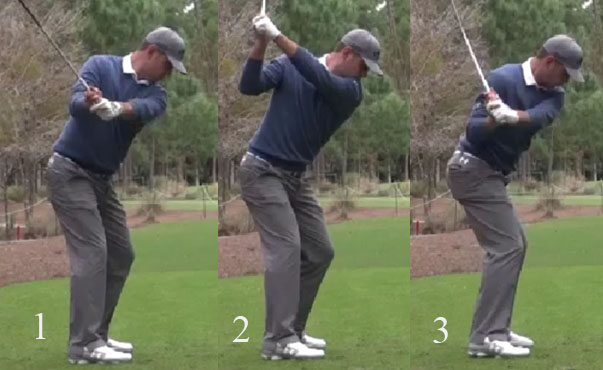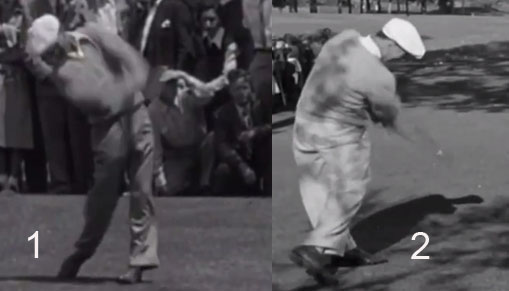|
|
Post by dubiousgolfer on May 12, 2020 10:47:24 GMT -5
Dr Mann
On your website you mentioned the following:
------------------------------------ Now consider another option of moving the hands/clubshaft during the "around-the-corner" transition zone between the mid-downswing and late downswing - and this option is called the combined "early left forearm + left wrist palmar flexion" option.
Gary Woodland is an example of a golfer who uses this combined "early left forearm supination + left wrist palmar flexion" option.
Gary Woodland swing video - www.youtube.com/watch?v=WUfnZuHPrvo
Here are capture images from that swing video.

Image 1 shows Gary Woodland at his end-backswing position with an intact LAFW and GFLW. Note that the clubface is parallel to the back of his left forearm, and that feature is characteristic of a golfer who has i) a neutral left hand grip and ii) who has no static clubface closure/opening phenomenon when first adopting a left hand grip at address.
Image 2 shows Gary Woodland at the end of his early downswing (P5 position) - note that he still has an intact LAFW and GFLW (slightly cupped left wrist).
Image 3 shows Gary Woodland just below the P5 position, and if you look carefully, you will note that his left wrist is slightly palmar flexed.
Image 4 shows Gary Woodland at the P5.3 - P5.5 position - his left wrist is now overtly palmar flexed and his left forearm is slightly supinated (compared to images 2 and 3 when the back of his left forearm was approximately parallel to the inclined plane). Note that his clubshaft's plane has not steepened even though his is supinating his left forearm slightly (which theoretically should steepen the clubshaft angle) and that is due to the fact that he is simultaneously palmar flexing his left wrist (which angles the clubshaft in an underplane direction). The two clubshaft-plane influencing phenomena cancel each other out and the clubshaft remains more-or-less on the same plane.
Image 5 shows Gary Woodland at the P6 position - note that the left forearm has supinated so much that the back of the lower left forearm is near-vertical, and not approximately parallel to the mid-downswing's clubshaft plane (as can be seen in image 3).
-------------------
When I look at image 3 , I noticed that the clubhead disappeared above the top of the image even though GW has adducted his right upper arm with a pitch elbow action. Doesn't that suggest that the clubshaft has become steeper at around P5.3?
If it has become steeper can we not surmise that the clubshaft has experienced the 'passive torque' effect in SMK's research due to the 'instantaneous hand path plane' being steeper than the clubshaft plane? Could this not have caused an early supination of GW left forearm and made the clubshaft steeper and 'Off Plane' ? That GW has to palmar flex his left wrist to get the clubshaft back on plane before release P5.5?
What I am suggesting is that this 'early supination and left wrist palmar flexion' is not just an optional 'around the corner' move but a necessity to keep the club on plane because of the SMK 'passive torque' effect . Could the degree of palmar flexion (and the rate it is applied) be directly related to any club steepening effect (that may topple the clubshaft off plane) due to the SMK passive torque effect?
Is the above a feasible proposition?
DG
On reflection, I think any palmar flexion would bring the sweetspot of the clubface back on plane while the clubshaft would be pointing just under the SPL.
|
|
|
|
Post by dubiousgolfer on May 13, 2020 8:57:39 GMT -5
|
|
|
|
Post by imperfectgolfer on May 13, 2020 9:41:42 GMT -5
DG, You wrote-: " When I look at image 3 , I noticed that the clubhead disappeared above the top of the image even though GW has adducted his right upper arm with a pitch elbow action. Doesn't that suggest that the clubshaft has become steeper at around P5.3?" No!
The clubhead disappears from view simply because the clubshaft is moving more upwards when the left arm moves downwards - while he is keeping the degree of lag unchanged. It will happen whether the clubshaft is shallowing, or not.
If you look at those capture images of GW, you can see that his proximal clubshaft is shallowing progressively from P4 => P5.5. At P4. his proximal clubshaft is just above the right shoulder (just above the TSP). At P5 (image 2) it cuts across his right shoulder socket. At P5.2 (image 3) it cuts across his right mid-arm. At P5.5 (image 4) it cuts across his right lower-arm. In other words, it is progressively shallowing. As it shallows, the left forearm must be pronating more - and that fact is confirmed by the 3-D graph. At P5.5, he starts to supinate his left forearm, and the blue graph in his 3-D graphs shows the early left forearm supination happening just prior to the start of the release of PA#2. That's a feature of his "early supination + left wrist palmar flexion" phenomenon - while most pro golfers (eg. Henrik Stenson) start to release PA#2 before they start to supinate their left forearm. Note that his left wrist flexion graph steepens dramatically at the same time as he starts to supinate his left forearm and note that it happens before the red graph starts to steepen.
Jeff.
|
|
|
|
Post by dubiousgolfer on May 13, 2020 10:14:32 GMT -5
Many thanks Dr Mann
DG
|
|
|
|
Post by utahgolfer on May 14, 2020 17:44:55 GMT -5
Jeff/DG Could you post a 3D graph of a player like Stenson, who doesn't have an early left forearm supination, alongside this one, as a comparison?  Is this graph basically saying that GW begins to supinate his right forearm and pronate his left forearm before p4, and continues this until about p5, at which point he reverses it, with right forearm pronation and left forearm supination? Is this graph also illustrating that GW begins to palmar flex his left wrist before p4 and slightly increases this until p5, at which point he dramatically increases left wrist palmar flexion (bowing) significantly until about p6.5? Is GW a drive holder, even though he has continued left forearm supination before and after p7? Is the amount of left forearm supination shown still minimal considering the speed and distance covered by the club head? Do you think GW exhibits more absolute left wrist ulnar deviation than Stenson (swinging into impact), putting more compressive stress on the ulnar side of GW's wrist? Do you think Hogan's 3D graph would look similar to GW's., which we see here? Could you speculate on the similarities and differences there might be? Thanks! UG |
|
|
|
Post by dubiousgolfer on May 14, 2020 21:31:24 GMT -5
Hi UG
I personally don't have a 3D graph of Stenson.
"Is this graph basically saying that GW begins to supinate his right forearm and pronate his left forearm before p4, and continues this until about p5, at which point he reverses it, with right forearm pronation and left forearm supination?"
If I've interpreted the graphs correctly , yes that seems to be the case.
"Is this graph also illustrating that GW begins to palmar flex his left wrist before p4 and slightly increases this until p5, at which point he dramatically increases left wrist palmar flexion (bowing) significantly until about p6.5?"
I think the bottom half of the graph is 'extension' so his lead wrist is getting less cupped up to P4 and continues to get less cupped until just after P5.5 where his wrist actually starts to become increasingly bowed (palmar flexion) more rapidly until P6.5.
I don't think GW is a DH'er and, after looking at some slow motion videos, he seems to have a 'non DH-full-roll hand release' action.
Not sure what you mean by minimal left forearm supination relative to distance covered by the clubhead but he does have quite a bowed wrist at impact which suggests he needs to supinate more than someone with a flat left wrist (and intact LAFW). He also has a smallish PA3 angle which might suggest that he has a higher ROC through impact than say someone with a large PA3 angle who might have a lower ROC per unit travel of clubhead.
"Do you think GW exhibits more absolute left wrist ulnar deviation than Stenson (swinging into impact), putting more compressive stress on the ulnar side of GW's wrist?"
From slow motion videos of Stenson , he seems to have a moderate PA3 angle so I can imagine that he has less ulnar deviation than GW (but it could also depend on each golfers grip pattern : finger grip , low-palmar, mid-palmar) . I haven't got a clue about extra compressive ulnar stress on GW's wrist.
"Do you think Hogan's 3D graph would look similar to GW's., which we see here? Could you speculate on the similarities and differences there might be?"
I think Dr Mann is more qualified to answer your last question and probably all of them :-)
DG
|
|
|
|
Post by imperfectgolfer on May 15, 2020 10:31:26 GMT -5
UG, You asked-: " Could you post a 3D graph of a player like Stenson, who doesn't have an early left forearm supination, alongside this one, as a comparison?" I don't have a graph of a golfer who uses an intact LAFW technique - like Henrik Stenson and Justin Rose. However, here is Phil Cheetham's graph showing a an "average" PGA tour golfer. Note that the blue graph only start to steepen after the red graph (representing the release of PA#2) steepens. Capture images show the differences well. Here are capture images of GW's mid-downswing. Image 1 is at P5.2, image 2 is at P5.5 and image 3 is at P6. Note that his left lower radial bone is pronated at P5.2 and becoming very supinated between P5.2 => P6. By comparison, here is Henrik Stenson. Image 1 is at P5.5, image 2 is at P6.2 and image 3 is at P6.5. Note that his left forearm is pronated at P5.5 and that there is very little left forearm supination happening between P5.5 and P6.2, and that his left forearm only looks as supinated as GW's P6-left forearm-alignment when he gets to P6.5.
Regarding GW's 3-D graph, you wrote-: "Is this graph basically saying that GW begins to supinate his right forearm and pronate his left forearm before p4, and continues this until about p5, at which point he reverses it, with right forearm pronation and left forearm supination?" The 3-D graph does not show any right forearm graph and there is no reason to believe that right forearm supination happens before P4. Left forearm pronation happens in the backswing to get the clubshaft on-plane and it increases in degree in the early downswing when he shallows his clubshaft between P4 and P5.2.
You asked-: "Is this graph also illustrating that GW begins to palmar flex his left wrist before p4 and slightly increases this until p5, at which point he dramatically increases left wrist palmar flexion (bowing) significantly until about p6.5?" The degree of increasing left wrist palmar flexion happening between P3.75 and P5 is very small and insignificant and he only dramatically increases his left wrist bowing after P5.2. You asked-: "Is GW a drive holder, even though he has continued left forearm supination before and after p7? Is the amount of left forearm supination shown still minimal considering the speed and distance covered by the club head?"
According to the 3-D graph, it looks like GW is continuously supinating his left forearm through impact, but capture images show that he is still a DHer to P7.2. Image 1 is at impact, image 2 is at P7.1, and image 3 is at P7.25. Note that he is supinating his left forearm between P7 => P7.25, but the degree is slow enough to allow him to be a DHer at P7.1 and a borderline DHer at P7.25 (when the clubshaft is just starting to bypass his left forearm from an angular rotational perspective). His clubface looks reasonably square to the clubhead arc between P7 and P7.2.
You asked-: "Do you think GW exhibits more absolute left wrist ulnar deviation than Stenson (swinging into impact), putting more compressive stress on the ulnar side of GW's wrist?" No. They both have a similar-sized accumulator #3 angle at impact. You asked-: "Do you think Hogan's 3D graph would look similar to GW's., which we see here? Could you speculate on the similarities and differences there might be?"
Hogan had much more left wrist cupping between P4 => P5.5 and the change to left wrist bowing was seemingly much more dramatic between P5.5 and P6.2. However, their 3-D graphs could otherwise probably be similar. Jeff.
|
|
|
|
Post by utahgolfer on May 15, 2020 13:38:17 GMT -5
Jeff/DG
Thanks for your excellent input. A very interesting thread.
Jeff: The 3-D graph does not show any right forearm graph and there is no reason to believe that right forearm supination happens before P4. Left forearm pronation happens in the backswing to get the clubshaft on-plane and it increases in degree in the early downswing when he shallows his clubshaft between P4 and P5.2.
The 3D graph shows only left arm action, but I simply assumed whatever the left forearm does, the right forearm is obligated to also do opposite-wise (since both hands contact the club's handle). I'm unsure how it's possible to have independent left and right forearm supination or pronation motion. Am I missing something? How can the right radial bone move more or less than the left radial bone, when both hands grip the club simultaneously?
At p5, the 3D graph shows GW starting to early supinate his left forearm. Doesn't this infer his right forearm is starting to early pronate a similar amount? If so, then before p5, we could assume the same...that the left forearm begins pronating before p4 and reverses to supination after p5 (and that his right forearm is supinating before p4 and reversing to pronation after p5)?
DG: I think the bottom half of the graph is 'extension' so his lead wrist is getting less cupped up to P4 and continues to get less cupped until just after P5.5 where his wrist actually starts to become increasingly bowed (palmar flexion) more rapidly until P6.5.
Jeff: The degree of increasing left wrist palmar flexion happening between P3.75 and P5 is very small and insignificant and he only dramatically increases his left wrist bowing after P5.2.
The green line excursion is gradual, but if you look at its overall increase in amplitude (toward increased bowing or palmar flexion) from before and immediately after p4, it appears to be significant, compared to GW's dramatic increase in left wrist palmar flexion beginning at p5. It would be interesting to see GW's backswing to p3.5 to see how much his left wrist looks cupped or dorsiflexed. Jeff, could you post his backswing photos from this swing? It is clear that he saves most of his left wrist palmar flexion for p5, but it is noteworthy if he begins to gradually minimize his left wrist dorsiflexion starting at p3 or so.
I asked-: "Do you think GW exhibits more absolute left wrist ulnar deviation than Stenson (swinging into impact), putting more compressive stress on the ulnar side of GW's wrist?"
Jeff: No. They both have a similar-sized accumulator #3 angle at impact.
It seems like palmar flexion puts more stress on the ulnar wrist tissue than does dorsiflexion, at a given #3 angle. It seems like when making a fist and palmar flexing the wrist fully, there is a motion bias (compression) toward the ulnar side, whereas as making a fist and dorsiflexing the wrist opens up the ulnar side more. I wonder if this has any effect on wrist injury?
I agree that GW is a drive-holder, but it seems like the early and active left forearm supination would make it harder for him to not continuously supinate his left forearm through impact.
Jeff, also thanks for the Hogan comparison. So, I assume Hogan had an early supination of the left forearm, like GW, and do you agree that Hogan also continuously supinated his left forearm through impact, but was still a DHer?
UG
|
|
|
|
Post by imperfectgolfer on May 16, 2020 9:57:02 GMT -5
UG, You wrote-: " The 3D graph shows only left arm action, but I simply assumed whatever the left forearm does, the right forearm is obligated to also do opposite-wise (since both hands contact the club's handle). I'm unsure how it's possible to have independent left and right forearm supination or pronation motion. Am I missing something? How can the right radial bone move more or less than the left radial bone, when both hands grip the club simultaneously?" You are missing the fact that the two forearms will only rotate the same amount (but in opposite directions) if the two forearms are parallel to each other. However, when the right elbow bends then the RFFW is at a variable angle relative to the LFFW, so there is no reason to believe that they should rotate the same amount. During the backswing, the right arm may abduct to different degrees in different golfers and the degree of right elbow bend will vary considerably at different time points between P1 => P4 in different golfers. Different golfers also vary in the degree of right humerus rotation during their backswing action and all these variables will create a multitude of different angles between the RFFW and the LFFW at different time points during the backswing. The same scenario applies to the downswing - when different golfers vary in the speed of right arm adduction, speed of external rotation of the right humerus, and degree of clubshaft shallowing action (necessitating more right forearm supination) - thereby creating a multitude of different potential angles between the RFFW and the LFFW between P4 and P6. After P6, when the right arm straightens, the two forearms will rotate more in unison. Here are capture images showing that discrepancy. Images 2, 3 and 4 show Martin Hall at the P3 position. His left forearm had to pronate to get his LFFW/clubshaft parallel to the inclined plane (swingplane), but he does not have to supinate his right forearm by the same amount because he is bending his right elbow and externally rotating his right humerus. You stated-: "At p5, the 3D graph shows GW starting to early supinate his left forearm. Doesn't this infer his right forearm is starting to early pronate a similar amount? If so, then before p5, we could assume the same...that the left forearm begins pronating before p4 and reverses to supination after p5 (and that his right forearm is supinating before p4 and reversing to pronation after p5)?" GW's right forearm is not pronating after P5 (between P5 and P6) and it is increasingly supinating.
Note that GW is starting to early supinate his left forearm between P5 (image 2) and P6 (image 4), but his right forearm is increasingly supinating (and not pronating) during that same time period.
You wrote-: "The green line excursion is gradual, but if you look at its overall increase in amplitude (toward increased bowing or palmar flexion) from before and immediately after p4, it appears to be significant, compared to GW's dramatic increase in left wrist palmar flexion beginning at p5. It would be interesting to see GW's backswing to p3.5 to see how much his left wrist looks cupped or dorsiflexed. Jeff, could you post his backswing photos from this swing? It is clear that he saves most of his left wrist palmar flexion for p5, but it is noteworthy if he begins to gradually minimize his left wrist dorsiflexion starting at p3 or so." Image 1 is at P3, image 2 is at P4 and image 3 is at P5. I don't see any significant change in his his degree of left wrist dorsiflexion between P3 => P5.
You asked-: "So, I assume Hogan had an early supination of the left forearm, like GW, and do you agree that Hogan also continuously supinated his left forearm through impact, but was still a DHer?"
I doubt that Hogan was continuously supinating his left forearm through impact in this swing action where he appears to be using a no-roll DH-hand release action combined with a CP-arm release action.
I wish that I had a slow motion video of Hogan's hand release action through impact to better understand his hand release action!!!!
Jeff.
|
|
|
|
Post by dubiousgolfer on May 16, 2020 18:40:54 GMT -5
Hi UG I found it difficult to understand why there isn't opposing rotations of the left and right forearms but you can actually do it yourself as an example. Take a neutral grip and while horizontally adducting/pronating your left arm to your chest simultaneously allow your right wrist to dorsiflex and right elbow to move into a punch elbow position behind your shirt seam. You will find that you don't have to supinate your right forearm as much as the left forearm pronates. We had an interesting thread about this back in 2018 concerning Kirk Junge. newtongolfinstitute.proboards.com/thread/660/rotation-left-forearm-rightDG |
|
|
|
Post by imperfectgolfer on May 16, 2020 19:26:36 GMT -5
Hi UG I found it difficult to understand why there isn't opposing rotations of the left and right forearms but you can actually do it yourself as an example. Take a neutral grip and while horizontally adducting/pronating your left arm to your chest simultaneously allow your right wrist to dorsiflex and right elbow to move into a punch elbow position behind your shirt seam. You will find that you don't have to supinate your right forearm as much as the left forearm pronates. We had an interesting thread about this back in 2018 concerning Kirk Junge. newtongolfinstitute.proboards.com/thread/660/rotation-left-forearm-rightDG One major reason why the right forearm does not have to supinate as much as the left forearm pronates between P1 => P3 is the fact that the right wrist increasingly bends back while simultaneously moving towards radial deviation thereby producing a clockwise circumductroy roll motion of the right wrist that causes the right palm to roll clockwise and thereby become more horizontally-angled. It can be seen in Martin Hall's takeaway action. Note that the degree of left forearm pronation happening between image 2 and image 3 by looking at the degree of clockwise rotation of his watchface. Note that MH is increasingly bending his right wrist back between image 2 and image 3 while also simultaneously increasing the degree of upcocking of his right wrist, and that will induce a small degree of right wrist circumductory motion, which will thereby decrease the amount of right forearm supination needed to get the right palm to be parallel to the left palm in image 3. Jeff.
|
|
|
|
Post by utahgolfer on May 16, 2020 23:01:01 GMT -5
Jeff/DG,
Amazing analysis of the golf swing. Thank you for the enlightenment!
UG
|
|





